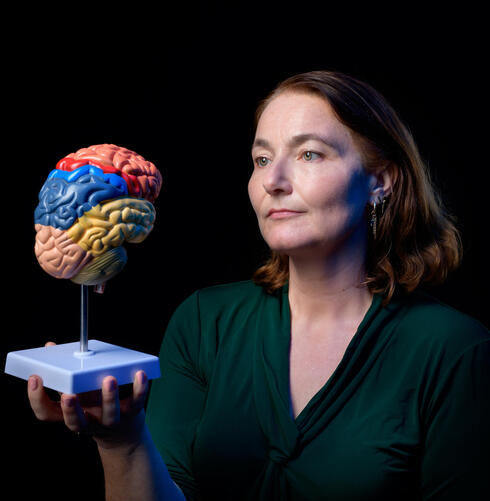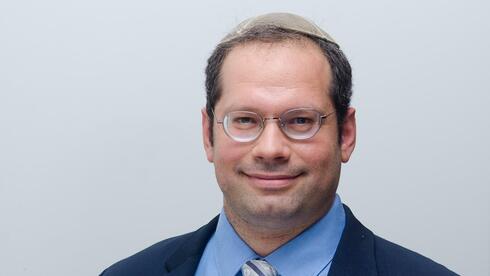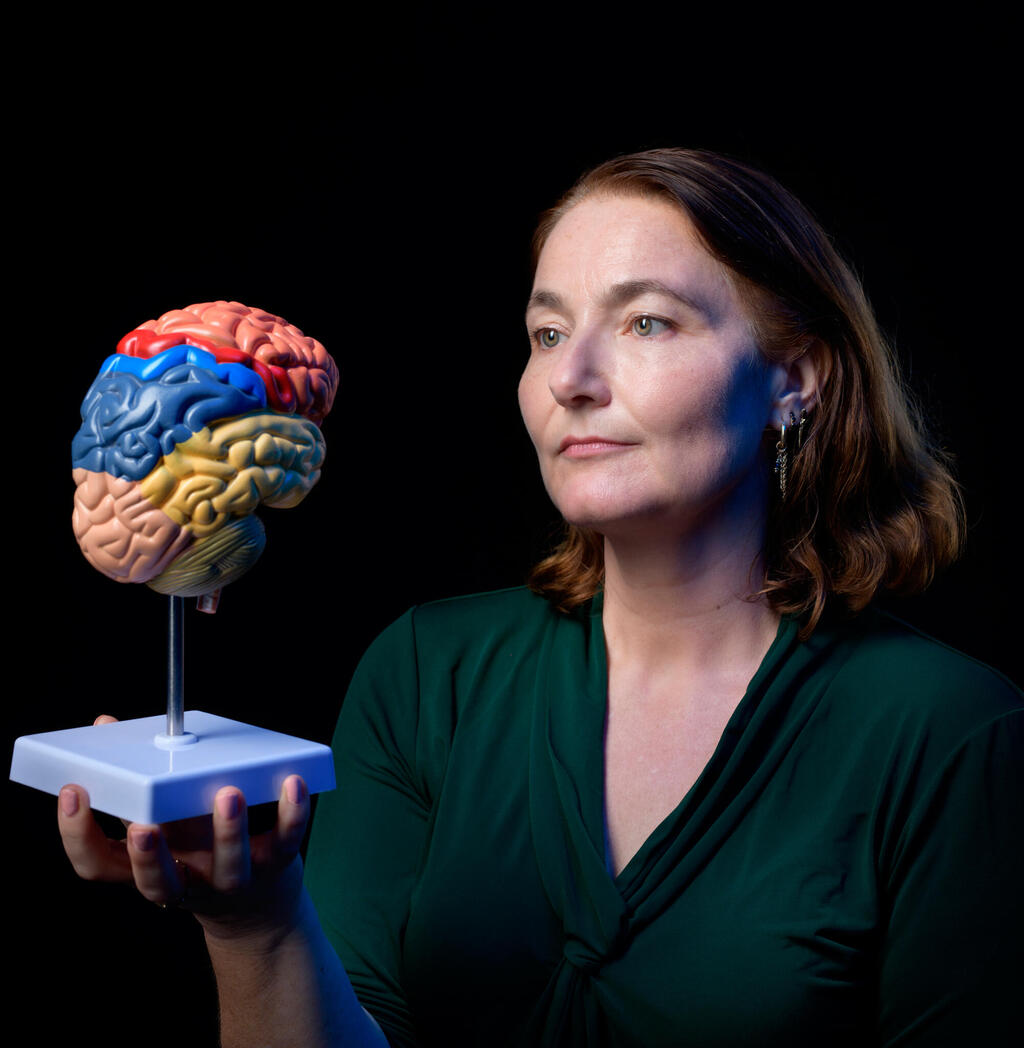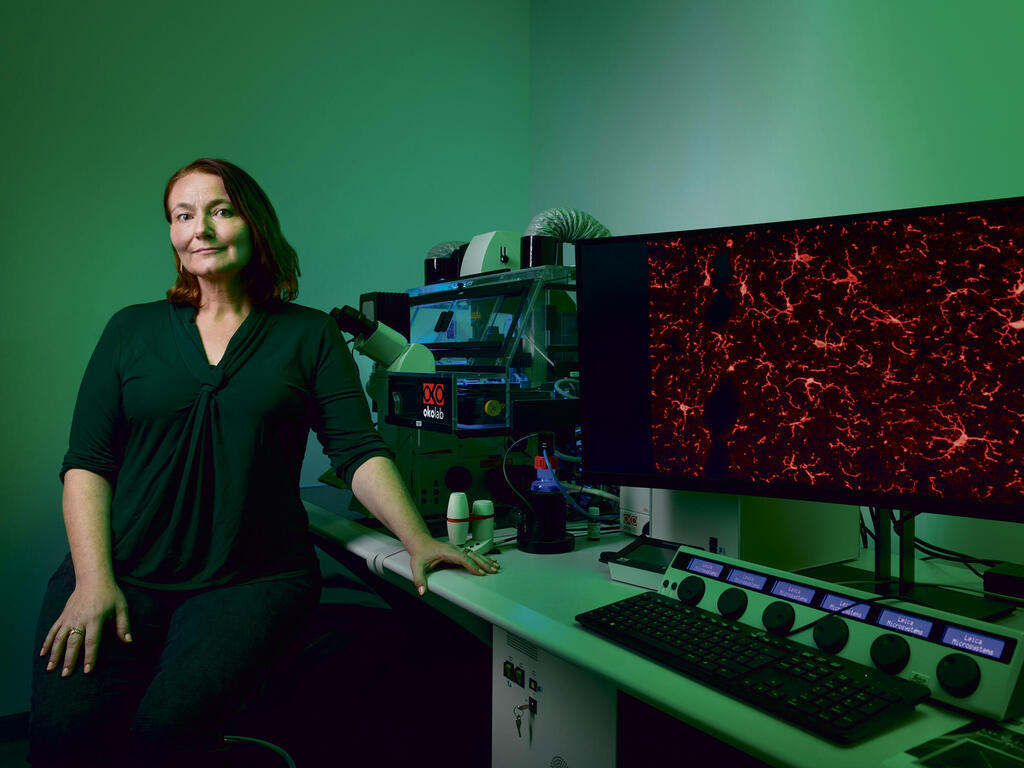
Of mice & women: Meet the doctor trailblazing towards a cure for aging
Dr. Linda Rubinstein's journey began by escaping from communist Prague, continued in the innovative laboratories of NASA, and now she is back, diving into the depths of the mitochondria of mice and humans. If her plan to play with cells is successful, the unusual route will lead to the understanding how to avoid dementia and towards treatments that are more suitable for women.
In 2017, Dr. Linda Rubinstein received from acquaintances in the Czech Republic an image of a poster for a local photography exhibition. In the center of the poster is a photo from the mid-1980s, in which 8-year-old Linda, her parents, and her younger sister are seen on a street in Prague. Rubinstein, formerly Gutman, never saw this photo. Strangers took it, probably from a car. The family members were not only exposed to a photograph they did not know, they were also exposed to a truth they did not know: they lived under the surveillance of the secret police in Czechoslovakia at the time, and it was they who took the photo that became part of the exhibition about Jewish life in Prague.
Two years after the photo was taken, when Linda was 10 years old, members of the Gutman family immigrated to Israel. "My parents tried to immigrate to Israel for many years and were not approved, but apparently towards the end there was a loosening of restrictions and people were allowed to leave," she says in an interview with Calcalist. And even then it wasn't easy, with or without being subject to surveillance. "We were allowed to leave with only four suitcases, and we had to declare that we were going to the United States, because we would not have been allowed to go to Israel."
The family came to Israel anyway, and lived in Haifa and Jerusalem. Rubinstein (47) developed a fascinating and prosperous scientific career as an astro-neuro-biologist, married Ran, a high-tech employee, and they gave birth to three children, now aged 16, 12 and 8. Her childhood in communist Czechoslovakia and her parents' immigration efforts were constantly in the background. They accompanied her when she moved to the United States seven years ago, and when she decided to return two years ago, even though she held a fascinating and rather rare research position at the world-renowned space agency. "My parents immigrated to Israel because of Zionism, and that's one of the reasons why it was important for me to return from my postdoc at NASA," she explains. "I could have stayed there, the work was cool and interesting, but I knew I would return."
And perhaps not only the return to Israel was dictated by this life story. Perhaps other career choices were also shaped on the basis of her childhood in Soviet Prague and the immigration experience. For example, the fact that Rubinstein focuses on a better understanding of the human body in order to improve the quality of life, in general and in old age in particular. For example, her preoccupation with how processes in the brain lead to impairment of memory, or stability. For example, the emphasis she has placed for years on gender medical observation, one that recognizes the differences between men and women and pushes for treatments that are more suitable for women. Even the fact that she was a partner in outer space research seems to be a direct continuation of the family and personal need to go beyond the limits of the existing, familiar world, in order to strive for a better place. And all of this, the innovation and breaking of boundaries and the ambition to crack something big, is done by Rubinstein by diving into the very small - into the cells of the human body, and specifically into the mitochondria within them.
The fountain of youth is nice, but quality of life is more important
For most of us, mitochondria are a dim memory from middle school biology class. Those who remember a little more will perhaps pull from the depths of their minds the explanation according to which this is the "power station of the cell", an organelles that is found in almost every cell in the human body and breathes for it, producing the necessary energy for it. But for Rubinstein, the mitochondria is the future.
She has been investigating it for years, and discovered that it is possible to "play" with it, to activate it in different ways, such that the effect on the body may be decisive in reducing cognitive diseases in old age, and perhaps even in extending life expectancy. Beyond that, it can help in understanding the factors of stress and social isolation in our lives, and in knowing the differences between men and women, so that it will be possible to adjust the right medicine for each person. As mentioned, Rubinstein went all the way to space to do this - some of the research she was involved in at NASA was done in space - and today she continues her journey at the Neuroscience Center at Sheba Medical Center. Whether it be Mars or Sheba, it probably doesn't matter much where we dive into the tiny foundation stones of our bodies.
"My lab mainly works on the connection between the immune system and mitochondria," explains Rubinstein. "We have special models that improve the work of the mitochondria, and we have seen that it improves cognitive processes related to aging, prolongs life, and prevents processes related to neurodegeneration, as happens in Parkinson's and Alzheimer's. When you activate the mitochondria with greater efficiency, you actually see that it erases the damage that accumulates in the brain. In the future, we want to actually develop such drugs."
What does it mean to activate the mitochondria?
"An important part of the mitochondria is oxidation-redox, a redox system — a process essential for maintaining the chemical balance in the cells, which affects the activity of enzymes and the functioning of the immune system and the body's ability to fight diseases, respond to the environment and maintain general health. This is especially important in the brain, because the neurons need a large number of functioning mitochondria to meet their high energy demands. A decrease in the activity and quality of mitochondria in the brain is linked to normal aging and a number of diseases. In my last year at NASA, we showed that balancing the redox system improved the mouse's ability to deal with various stressors (stress factors) such as social isolation and radiation, and eliminated signs of inflammation in the brain that resulted from them."
And how can it be balanced? What do you do?
"We create a transgenic mouse, that is, a mouse into which foreign DNA has been inserted - we take a human enzyme and overexpress it inside the mouse, so that the enzyme works more efficiently. It balances the redox system in situations where the mouse is subjected to various stresses, and improves its response to stress - it becomes more immune to it."
Part of the source of her attraction to mitochondria, it turns out, lies in her being a woman. "Fibromyalgia and chronic fatigue are diseases that are more common among women, and they are part of what we are currently researching at Sheba together with doctors," she explains. "For decades, because of the narrative that 'women are hysterical' and all kinds of nonsense, the medical treatment of such women was compromised. Women suffered to the extent that they could not get out of bed, and were sent to a psychiatrist. But in recent years, studies have been published that showed a direct link between these diseases and mitochondria. It was innovative, and that's why I also entered the field."
And when she entered, she got deep into the world of diseases of old age. The field of longevity, which is designed to extend life, has received hype in recent years, but Rubinstein says that "I am not interested in preventing aging and extending life - but in giving a good quality of life in the time we have. Life expectancy is increasing significantly, and in Europe, for example - where on the one hand there are not many births, but on the other hand, there are many older people - it is absolutely necessary to raise the productivity age, because there are predictions that in a few years the economy will not be able to contain it. There is great importance here beyond fantasies about the eternal fountain of youth, and I think that the redox system in the mitochondria and the relationship between it and the immune system will be a significant part of that."
According to a large-scale study by the University of Washington, published two years ago in the respected medical journal The Lancet, the number of people with dementia worldwide will triple by 2050, from 50 million to more than 150 million. About 70% of people with dementia are Alzheimer's patients, and despite huge investments in the field, there is still no cure for it. Rubinstein tries to get there not only through theoretical research or work with mice, but also through research with humans. "That way you can reach a solution or even a cure much faster," she explains. "This is a major reason why I wanted a laboratory in a hospital - you can work on samples from patients. A second reason, no less important, is the multidisciplinarity, which is necessary for improving the quality of life and researching aging, which is a complex thing. The meeting with researchers from other fields and with doctors, a meeting that suddenly makes it possible to suddenly think about something you hadn't thought about before, it really accelerates things."
Can you prevent your Alzheimer's?
To clarify what this means, Rubinstein leads me to her lab mice. "We give them tests that are similar to what is done to people with neurodegenerative diseases," she explains. "The mouse is walking, and our device examines all the parameters of its posture and walking, and there are 500 such parameters. There are things that the eye can see, which are also seen in people with diseases such as Parkinson's and Alzheimer's, and which make it possible to identify the patient, but there are things that the eye cannot see but tests like these make it possible to identify and predict the diseases. This mouse for example" - she points to a particularly slow one - "you can see with the naked eye that its pattern is different. But there are patterns that only the software, only artificial intelligence analysis, can detect." Not only walking and posture, it can also detect memory impairment in mice and other cognitive declines, through tests of mazes, social interactions, search and more. "You can really see what strategy they are using," she says.
"So we have parameters of memory, anxiety, social behavior, sensory-motor elements, and alongside them we analyze blood and brain cells, and there we also look for early biomarkers (biological markers) for neurodegenerative diseases, including those that are not known today to have a role in these diseases. And once some suspicious marker is identified, it can also be looked for in humans."
As with the emphasis she places on working with other researchers, even within the research itself the key for her is the connections. "Since these diseases are very complex, we are actually building models of a lot of combined signs. It's not that we expect to find one sign and that's it, it's a synergy that can provide a prediction not only if there will be a disease, but also what its nature will be and which treatment will be most suitable. This is also where differences come into play between men and women - we saw a different immune response in the brains of mice and rats - and today when developing drugs they don't take these differences into account."
But at the moment there is still no cure, so how significant is the prediction of the developing disease?
"This is something that not everyone necessarily knows, and we emphasize it in applications for research grants - up to 40% of dementia cases are preventable" - by identifying 12 risk factors, including blood pressure, exposure to air pollution, head injuries and more. "The tendency is to think that everything is genetic and predetermined, so it's nice, even optimistic, to know that maybe you do have some kind of control and you can make a difference. If we can follow people aged 40-50, those ages that don't deal with it yet, and find markers in them that predict such diseases. It will be possible to give them personal recommendations to change their lifestyle, and this will have an effect."
The mice from Mars make new discoveries
Rubinstein completed a bachelor's degree in biology at the Hebrew University, continued there for a master's degree in physiology at the Faculty of Medicine, and then earned a doctorate in microbiology at Tel Aviv University. Then she went to Berkeley, for a post-doctorate, and discovered that this was not a simple matter. "I already had three children, the youngest was one and a half years old, and I felt strange," she says. "Most of the researchers in the lab were younger than me, none of them had children, and the culture was of very long working hours. Around us were parents who only met me after six months and said to me: 'But you're not real.' It turned out that they thought my partner was a single father, that he was making me up, they would meet him in the park on Saturday morning with all the kids and he would say 'Linda is at work'.
"In short, there was no adjustment period, nor did I ask for it, but in the end it's not something that can be hidden or even dealt with successfully for a long time. Even from my supervisor's point of view, the feeling was that you are less devoted to research because you are a mother, and that is not true, after all, for a human being there can be hobbies outside of work. My lesson from the time there is that when you come across such an unsuitable place, you should try to look for another place."
And to that was added the fact that even then, in 2017, Israeliness was an issue at the prestigious university that has become associated with pro-Palestinian protests. "I felt uncomfortable with a lot of people, receiving a cold shoulder from all kinds of sources. Many times I worked at night and one night the lab's printer was full of pages with swastikas."
After a year of research there, she looked for an alternative postdoctoral position, and arrived at the Ames Research Center that NASA operates in Silicon Valley. She stayed there for four years and directed research that received grants of approximately $1.8 million. "My research was on the effect of stressors on the brain and on behavior. These are stress factors that all exist in space and some of them also exist on Earth - social isolation, free radicals, radiation and the absence of gravity. The intention was to understand how they would affect astronauts on long-term and prolonged trips, especially to Mars, because there is concern from previous studies that this would affect their brains and behavior."
To understand what happens to astronauts on Mars, Rubinstein needed mice. And there two important discoveries were found. The first - "We saw that, surprisingly, social isolation caused more damage to the brain and the immune system than weak radiation." And the second - "We saw that if we activate the mitochondria better, i.e. balance the redox, the signs of inflammation in the brain disappear. When in response to stress the mitochondria of the mice worked much more efficiently and strongly, we were able to prevent the manifestations of social isolation that we saw in the brain."
The potential of this understanding does not end with astronauts. "After all, during the pandemic we were like astronauts, alone, without moving our muscles enough. It harmed the brain, not just the muscles. And if the mitochondria is also related to radiation damage, this could be the basis for protective measures for those receiving anti-cancer treatments. So there may be certain situations when there are things that we cannot prevent, but maybe we can prevent some of the damage."
The team she worked with sent mice into space, and the model she is currently building, the one that takes care of strengthening a specific enzyme in mice, will also be tested on the animals in the spacecraft. Research in space is important because due to the distortion in time, aging is accelerated there, and various phenomena known from Earth are exaggerated there. "There are quite a few studies that show a great effect of the space environment on the brain, but we don't always know how to separate the factors: Is it the radiation? Is it the changes in microgravity? Is it because the liquids go to the head? There is evidence of changes in vision, blurring, headaches , migraines, and also fog in the brain and a swollen face, and we don't know how to explain everything, so it's important to try to understand the various factors and separate them. This is significant for the work of astronauts - let's say you want to go to Mars and there is a solar flare on the way with radiation at a level that can kill you, it's important that we understand the various effects of radiation on the brain and the heart - and this is also important for our understanding of our life here, the understanding of neurodegenerative diseases and the connection to the immune system."
And besides all that, is it fun to work at NASA?
"The atmosphere there is great. All employees are passionate about the subject. At universities there are different groups that sometimes compete with each other, but NASA doesn't have that, there is excellent cooperation, which is nice."
In her laboratory, she keeps to this day signed photos of two astronauts: Christina Hammock Cook, a flight engineer on three missions to the International Space Station, who is the astronaut who stayed in space for the longest consecutive time (328 days); and Megan McArthur, a pilot on the space shuttle Atlantis to the Hubble telescope and on a NASA and SpaceX mission to the International Space Station. "They visited us at Ames, amazing women who went through grueling training to become astronauts, and what impressed me the most was that they had a sense of humor about themselves. One of them, for example, lives close to the base in California, with her parents, and she said that her father gave her his car but was reluctant, he told her: 'It's terribly difficult to drive here, there is a lot of traffic.' So she answered: 'I drive a spaceship, it's a little more difficult.'"
A constant war on gender blindness, in the laboratory and in the world
The effect of stressors keeps her busy even today in a laboratory supported by the Sheba Research Authority, where she leads a team of five employees. And not only did she bring this issue from NASA, but also the agenda of gender medicine. "NASA currently has 50% female astronauts," she explains, and under this egalitarian umbrella she discovered, among other things, that there are big differences in the exercise response of males and females for stress. Now, in parallel with her work in the laboratory, she is engaged in the establishment of a new platform called Living Lab, which focuses on fibromyalgia and combines the work of researchers and doctors, from hospitals, industry and academia, in order to optimize and accelerate the development of new treatments and their implementation. Here, too, the emphasis is on connections - and a direct meeting with the women dealing with the disease. "This is something that over time I would like to adopt in different diseases. Seeing the people speeds us up, the researchers. Psychologically, when you meet them it strengthens you not to give up and help them. It is important to see the result and understand that what you do can affect people's quality of life.”
Gender medicine is a field that has been developing a lot in recent years, among researchers as well as therapists, and it seems that the more people understand the need for it - the more the need grows. There is a whole ocean of knowledge here that we do not yet understand. "Once you see that there are different reactions in the brain, different pathways that are activated in males and females, it is critical," explains Rubinstein. "This is critical, for example, when you develop drugs, or even try to see markers. And these differences are far from being known in all diseases and in all stressors. Now we are starting to pay attention to this, we are starting to collect this data in all kinds of fields, but this does not compensate for all the research to date. Looking for a reference to the differences in the articles, it simply doesn't exist. As soon as there is a focus on it, as soon as other factors are taken into account, it can speed up the development of technologies."















